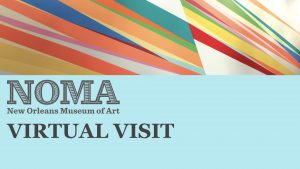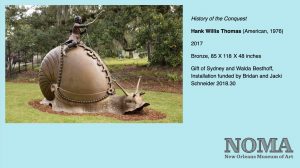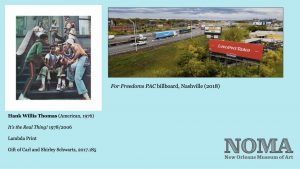For Paige Valente, and millions of fellow teachers across the nation, the 2020 school year has redefined education as schools closed due to the pandemic and instruction moved online. As an art teacher at Edna Karr High School, Paige quickly adjusted to a cyber-based classroom format, greeting and guiding her students in Google Classroom rather than a physical classroom. She sought new digital resources for these inquisitive teens and discovered that NOMA too had adapted to a rapidly changing learning environment. The museum launched Virtual Visits in lieu of field trips, led by Curator of Education Tracy Kennan and Learning and Engagement Assistant Connor Kilian. Paige shared her thoughts about the program with David Johnson, Editor of Museum Publications.
How long have you been teaching and what led you to become an art teacher?
I’ve been teaching full-time for the past five years. I worked previously as a teaching artist, so my teaching experience totals 12 years. I began working as a teaching artist through Silence is Violence [a nonprofit organization aimed at reducing violent crime in New Orleans], and then I stepped in as their art-programming director, which led me into the classroom and out of my graphic design practice. I just received much more gratification working with students. I still practice as an artist, but my joy comes from the classroom.
Obviously things took a radically different turn for teachers this year with the pandemic, as it did for many professions, but much attention has been paid to the challenges faced by teachers. How have you adapted?
Going back to March 13, when we all learned that we were going to be home indefinitely, the adaptability factor just immediately took effect in setting up a Google Classroom, and asking, How do we sustain educating the students that are now at home in an especially trying time of this unknown virus? We kept hope that by fall we might all be back in the classroom. As we all know, that didn’t happen immediately. So learning how to teach art virtually has been a rewarding challenge for me, especially because teaching art is such a very personal shared space and community oriented. I need to be able to see what you’re doing to help you through your process. How do you transition that to a virtual platform which involves special arms to hold various phones with cameras and switching between desktop to a camera to do demonstrations while trying to avoid an echo?
It’s really a circus act at this point, but I think it helped with my teaching practice in a way. I have to be very streamlined and intentional because it’s so removed from what is normal. I really went hunting for opportunities on museum websites for field trips that I would typically take my students on, so that we could continue with something that would be normal. I want to give them art appreciation in a real-world context and not just the classroom. A lot of my students have never had exposure to the visual arts before, and I want them to understand that you don’t necessarily need to know how to draw to understand art appreciation and how art exists in our everyday living.
How did you find out about NOMA’s virtual tours?
I went to the website. I’m invested in the New Orleans art community, and I think I just went and looked to possibly what exhibits were up and how I might be able to share them with my students, and from there I learned that there was actually a way that NOMA could share the material with us. That was really exciting.
Did the virtual tour live up to your expectations? How did it work for you?
It went beyond my expectations. So the way that we managed tour was through Google Classroom. With my school’s permission and InspireNOLA’s assistant, the school created Edna Karr email addresses for NOMA staff so that they could get access into my classrooms, my virtual classrooms, I should say, and there’s six of them, and each class had their own tour. So Tracy and Connor have virtually logged in as another teacher or a student would and shared their screen to be able to talk to kids about art that’s focused on social justice issues.
The virtual tour was a narrated slideshow. Since I had six classes I said, Could you vary them across all six classes with the theme? There are different themes that we could choose, whether that be social justice or the elements of art or art and ecology. For my students, I felt that social justice would serve them well. So in each of my classes both Tracy and Connor randomly selected three different artworks to cover within a thirty-minute class period.
That virtual field trip led us to explore other works. We looked at a work by Hank Willis Thomas, and that prompted us to do more research on him. His work focuses around what message is actually being sold in an advertisement. Is it actually the product or are they selling us an idea? So we were able to take what we learned at NOMA and build on that idea.
What would you tell other teachers about NOMA’s virtual field trips?
I would highly recommend them. Our museums are here still in spite of the pandemic, they’re part of our community, and we need them to preserve culture and arts, and to tell narratives that are not necessarily or ever told in general educational classrooms. They’re available, they’re free, and it gives students an opportunity to do something different, right now on their computers.
We’ve become so programmed to just log in every day and do something that’s something completely unnatural to what we’ve ever done in the past, in terms of education and learning. And by having a variance—a different type of experience—it gives students an opportunity to be a part of the world outside of what may be perhaps the bedroom that they sit in most every day in front of a screen. So to understand that there is an extension of our lives that is still available to us, and one that will be there on the other side of this when it’s over, that’s important. Plus it’s just imperative that students have access to the arts, first and foremost.
Bring art into your classroom or directly to students at home! Virtual Visits are thirty-minute live art discussions via a video-conferencing platform of your choice. Each scheduled session includes a pre-visit consultation to customize your experience. During the live Virtual Visit, a museum educator presents students with three works of art, asking open-ended questions and making connections to the selected theme. Each Virtual Visit is standards-based and includes teacher-led lesson plans and activities for students to complete before and after the session.


